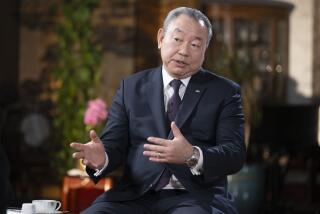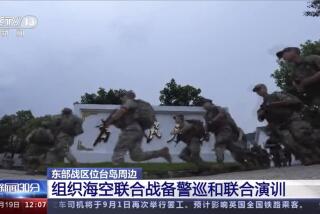In a snub to China, the U.S. lets Taiwan’s president spend some time in New York
- Share via
Reporting from Taipei — In 2006, when Taiwan’s then-President Chen Shui-bian was flying east and needed to refuel, the United States forced him to do it in out-of-the-way Anchorage.
He complained that the stop was “inconvenient, uncomfortable and indecent.”
But U.S. officials were worried that a higher-profile location would have upset China because Chen had been particularly outspoken in defending Taiwanese sovereignty.
China, which considers self-ruled Taiwan to be part of its territory rather than an independent state with rights to diplomacy, has long bristled over attention-grabbing activities by Taiwanese leaders in the United States .
These days, the U.S. government isn’t trying to hide such visits. On Thursday, Taiwan President Tsai Ing-wen arrived in New York for two days. Later this month, she is scheduled to pass through Denver for two more days.
The stops reflect President Trump’s growing closeness to Taiwan as his administration raises pressure on China over trade and its military expansion in Asia.
Last August, in a move that riled China, Tsai became the first Taiwanese president since the 1970s to visit a U.S. federal property, NASA headquarters in Washington.
And on Monday, the State Department approved a $2.2-billion sale of tanks, missiles and other defense equipment to Taiwan.
“President Tsai’s relationship with the U.S. is far better than predecessors,” said Liu Yih-jiun, public affairs professor at Fo Guang University in Taiwan. “At this moment, both the Taiwan and U.S. governments prefer to see this as one step further in enhancement of diplomatic relations.”
The U.S. government has been letting Taiwanese leaders stop over since the 1990s — in the name of comfort and convenience — a couple of times a year when they were on their way to see formal diplomatic allies in Latin America or elsewhere.
But the locations, time frames and activities allowed regarding those landings have been a barometer both of U.S.-Taiwan relations and how the two sides regard China at any given moment.
Keen to build economic ties with China, Presidents Clinton, George W. Bush and Obama would often restrict stops to distant spots such as Anchorage or Guam, sometimes just for hours rather than days. Any meetings were pro forma and low-key.
In 2013, a peak year for China-Taiwan relations, Taiwan’s then-President Ma Ying-jeou visited New York for 40 hours.
Today, relations are far more strained.
Tsai, acutely aware of anti-China sentiment at home since she took office in 2016, openly backs stronger self-rule for Taiwan over Beijing’s goal of eventual unification.
The foreign ministry in Beijing protested Tsai’s trip this month before she set out.
“This is a pretty long transit to begin to begin with, and New York by itself carries a large amount of political significance,” said Yun Sun, East Asia Program senior associate at the Stimson Center think tank in Washington. “Because Tsai Ing-wen’s position has been vehemently opposed to and criticized by the mainland government, that also makes [the visit] appear to be a little more provocative.”
Between her U.S. stops, Tsai is scheduled to visit Haiti, St. Lucia, St. Vincent and the Grenadines and St. Kitts and Nevis in the Caribbean.
Aaron Huang, acting spokesman for the de facto U.S. embassy in Taipei, said overall policy toward stopovers had not changed but declined to say why Tsai was given stops totaling four days.
Jennings is a special correspondent.
More to Read
Sign up for Essential California
The most important California stories and recommendations in your inbox every morning.
You may occasionally receive promotional content from the Los Angeles Times.










